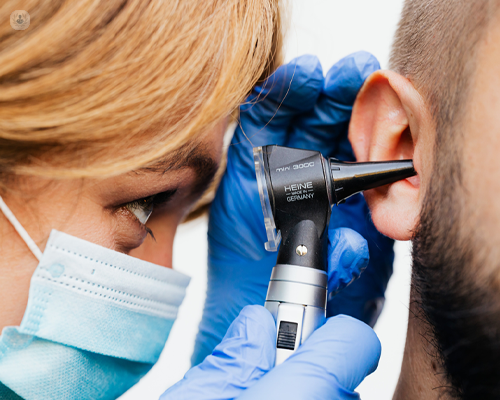Grommet surgery in adults: What to expect
Written by:Grommet surgery, also known as tympanostomy or ventilation tube insertion, is a common procedure aimed at treating glue ear in adults. If you’re an adult with glue ear considering grommet surgery, you may have some questions about the procedure and what to expect.
This article from leading adult and paediatric consultant ENT surgeon Miss Laura Harrison aims to provide informative answers to the main questions you might have before undergoing grommet surgery.

What is glue ear?
Glue ear, medically known as otitis media with effusion (OME), is a condition where a sticky fluid accumulates in the middle ear, leading to hearing problems and discomfort. While it commonly affects children, adults can also develop glue ear due to various factors such as sinus infections, allergies, or Eustachian tube dysfunction.
What is grommet surgery?
Grommet surgery is a minor procedure where an ear, nose, and throat surgeon inserts tiny ventilation tubes, called grommets, into the eardrum. These grommets allow proper ventilation of the middle ear and drainage of fluid, relieving pressure and restoring hearing.
Am I a suitable candidate for grommet surgery?
Adults with persistent glue ear and hearing difficulties that affect their daily life may be suitable candidates for grommet surgery. If you have tried other treatments such as antibiotics or nasal sprays without success, grommet insertion could be an appropriate option.
What happens before the surgery?
Before grommet surgery, you will have a thorough consultation with an ENT specialist. During this consultation, your medical history will be reviewed, a detailed examination of your ears, nose and throat will be conducted, and your hearing will be assessed. You may require further investigations such as an MRI scan.
Is grommet surgery performed under anaesthesia?
Yes, grommet surgery is performed either under local or general anaesthesia. With local anaesthesia, cream is used to numb the ear and with general anaesthesia you will be asleep and will not experience any pain or discomfort.
How is the grommet surgery performed?
During the surgery, the ENT surgeon will make a small incision in the eardrum to access the middle ear. Any accumulated fluid will be drained, and a tiny grommet will be inserted into the opening. The grommet will stay in place for a few months to allow proper ventilation.
What can I expect after the surgery?
You will be monitored in a recovery area until the anaesthesia wears off. It is normal to experience some mild discomfort, which can be managed with pain medication if needed. Your ear may also feel slightly blocked, but this sensation will improve as the ear heals.
Are there any risks or complications?
Grommet surgery is generally safe, but like any medical procedure, it carries some risks. These risks include:
- infection;
- bleeding;
- scarring of the ear drum or a hole in the ear drum that does not heal.
However, your ENT surgeon will discuss these potential risks with you and take appropriate measures to minimise them.
What is the recovery process like?
The recovery process after grommet surgery is usually straightforward. You may be advised to avoid getting soapy water in your ears whilst the grommets are in place and to refrain from activities such as scubadiving.
Will grommets need to be removed?
In most cases, grommets are designed to fall out on their own after a few months. If they do not come out naturally, a follow-up appointment with your ENT surgeon will be scheduled to assess their condition. If necessary, the grommets can be easily removed during a short, outpatient procedure.
What results can I expect?
Grommet surgery has a high success rate in improving hearing and reducing glue ear symptoms. Many patients experience immediate relief after the procedure and find their hearing significantly improved.
If you are an adult with glue ear and considering grommet surgery, it’s essential to consult with a qualified ENT surgeon to determine if you are a suitable candidate. Grommet surgery can offer effective relief from glue ear symptoms and help restore your hearing, improving your overall quality of life. Remember to discuss any concerns or questions you have with your doctor.
If you require surgical attention for glue ear, arrange a consultation with Miss Harrison via her Top Doctors profile.


